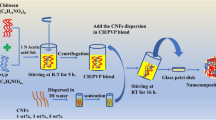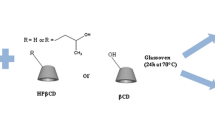Abstract
A novel solid bacterial cellulose/cotton fibers (BCF) composite with a sandwich-like structure as active and intelligent food packaging was formed in situ. BCF or bacterial cellulose (BC) films were vacuum dried and different concentrations of curcumin were absorbed in the films. Scanning electron microscopy showed cotton fibers were combined with BC, and formed a sandwich-like structure. The elongation at break, water solubility, swelling degree, thermal stability, UV barrier property and antioxidant property of films were increased with the cotton fibers in the films. For studying the interaction between solid support and curcumin, Fourier-transform infrared spectroscopy and X-ray diffraction spectroscopy were conducted. Curcumin was successfully doped into solid support films. With the addition of curcumin, the water solubility, tensile strength and swelling degree of films decreased, while elongation at break, thermal stability and UV barrier property increased. When the concentration of curcumin was the same, BCF based films presented improved antioxidant property and more visible color changes than BC based films. The BCF-curcumin films exhibited a color change from bright yellow to brownness with pH variations ranging from 7 to 10. These results indicated that BCF-curcumin films have the ability to be utilized as an active and intelligent food packaging.







Similar content being viewed by others
References
Anand P, Kunnumakkara AB, Newman RA, Aggarwal BB (2007) Bioavailability of curcumin: problems and promises. Mol Pharm 4:807–818
Balbinot-Alfaro E, Craveiro DV, Lima KO, Costa HLG, Lopes DR, Prentice C (2019) Intelligent packaging with pH indicator potential. Food Eng Rev 11:235–244
Brody AL, Bugusu B, Han JH, Sand CK, McHugh TH (2008) Molecular pharmacology. J Food Sci 73:R107–R116
Cacicedo ML, Castro MC, Servetas I, Bosnea L, Boura K, Tsafrakidou P, Dima A, TerpouKoutinasCastro AAGR (2016) Progress in bacterial cellulose matrices for biotechnological applications. Bioresour Technol 213:172–180
Cazon P, Velazquez G, Vazquez M (2019) Characterization of bacterial cellulose films combined with chitosan and polyvinyl alcohol: evaluation of mechanical and barrier properties. Carbohydr Polym 216:72–85
Curayag QAL, Dizon EI, Hurtada WA (2019) Antioxidant activity, chemical and nutritional properties of raw and processed purple-fleshed sweet potato (Ipomoea batatas Lam). Cogent Food Agric 5:1662930
de Abreu DAP, Cruz JM, Losada PP (2012) Active and intelligent packaging for the food industry. Food Rev Int 28:146–187
Enescu D, Cerqueira MA, Fucinos P, Pastrana LM (2019) Recent advances and challenges on applications of nanotechnology in food packaging: a literature review. Food Chem Toxicol 134:110814
Faham S, Ghavami R, Golmohammadi H, Khayatian G (2019) Spectrophotometric and visual determination of zoledronic acid by using a bacterial cell-derived nanopaper doped with curcumin. Microchimica Acta 186:719
French AD (2014) Idealized powder diffraction patterns for cellulose polymorphs. Cellulose 21:885–896
Gennadios A, Hanna MA, Kurth LB (1997) Application of edible coatings on meats, poultry and seafoods: a review. Lebensm Wiss Technol 30:337–350
Goel A, Kunnumakkara AB, Aggarwal BB (2008) Curcumin as "Curecumin": from kitchen to clinic. Biochem Pharmacol 75:787–809
Gupta A, Keddie DJ, Kannappan V, Gibson H, Khalil IR, Kowalczuk M, Martin C, Shuai Radecka XI (2019) Production and characterisation of bacterial cellulose hydrogels loaded with curcumin encapsulated in cyclodextrins as wound dressings. Eur Polym J 118:437–450
Han J-W, Ruiz-Garcia L, Qian J-P, Yang X-T (2018) Food packaging: a comprehensive review and future trends. Compr Rev Food Sci Saf 17:860–877
Hatcher H, Planalp R, Cho J, Tortia FM, Torti SV (2008) Curcumin: from ancient medicine to current clinical trials. Cell Mol Life Sci 65:1631–1652
Horrocks AR, Eivazi S, Ayesh M, Kandola B (2018) Environmentally sustainable flame retardant surface treatments for textiles: the potential of a novel atmospheric plasma/UV laser technology. Fibers. 6:31
Igarashi T, Hoshi M, Nakamura K, Kaharu T, Murata K (2020) Direct observation of bound water on cotton surfaces by atomic force microscopy and atomic force microscopy-infrared spectroscopy. J Phys Chem C 124:4196–4201
Islam S, Bhat G (2019) Environmentally-friendly thermal and acoustic insulation materials from recycled textiles. J Environ Manage 251:109536
Khalil H, Bhat AH, Yusra AFI (2012) Green composites from sustainable cellulose nanofibrils: a review. Carbohydr Polym 87:963–979
Kuswandi B, Jayus Larasati TS, Abdullah A, Heng LY (2012) Real-time monitoring of shrimp spoilage using on-package sticker sensor based on natural dye of curcumin. Food Anal Method 5:881–889
Li X, Li D, Zhang Y, Lv P, Feng Q, Wei Q (2020) Encapsulation of enzyme by metal-organic framework for single-enzymatic biofuel cell-based self-powered biosensor. Nano Energy 68:104308
Li X, Lv P, Yao Y, Feng Q, Mensah A, Li D, Wei Q (2020) A novel single-enzymatic biofuel cell based on highly flexible conductive bacterial cellulose electrode utilizing pollutants as fuel. Chem. Eng. J. 379:122316
Liang T, Sun G, Cao L, Li J, Wang L (2018) Rheological behavior of film-forming solutions and film properties from Artemisia sphaerocephala Krasch gum and purple onion peel extract. Food Hydrocoll 82:124–134
Ma Q, Du L, Wang L (2017) Tara gum/polyvinyl alcohol-based colorimetric NH3 indicator films incorporating curcumin for intelligent packaging. Sensor Actuat B Chem 244:759–766
Ma Q, Ren Y, Wang L (2017a) Investigation of antioxidant activity and release kinetics of curcumin from tara gum/polyvinyl alcohol active film. Food Hydrocoll 70:286–292
Ma Q, Ren Y, Wang L (2017b) Investigation of antioxidant activity and release kinetics of curcumin from tara gum/polyvinyl alcohol active film. Food Hydrocoll 70:286–292
Mizuno M, Kamiya Y, Katsuta T, Oshima N, Nozaki K, Amano Y (2012) Creation of bacterial cellulose-fabric complexed material. Sen-I Gakkaishi 68:42–47
Mocanu A, Isopencu G, Busuioc C, Popa O-M, Dietrich P, Socaciu-Siebert L (2019) Bacterial cellulose films with ZnO nanoparticles and propolis extracts: Synergistic antimicrobial effect. Sci Rep 9:17687
Mueller P, Schmid M (2019) Intelligent packaging in the food sector: a brief overview. Foods 8:16
Padrao J, Goncalves S, Silva JP, Sencadas V, Lanceros-Mendez S, Pinheiro AC, Vicente AA, Rodrigues LR, Dourado F (2016) Bacterial cellulose-lactoferrin as an antimicrobial edible packaging. Food Hydrocoll 58:126–140
Pourjavaher S, Almasi H, Meshkini S, Pirsa S, Parandi E (2017) Development of a colorimetric pH indicator based on bacterial cellulose nanofibers and red cabbage (Brassica oleraceae) extract. Carbohydr Polym 156:193–201
Shi ZJ, Zhang Y, Phillips GO, Yang G (2014) Utilization of bacterial cellulose in food. Food Hydrocoll 35:539–545
Sonkaew P, Sane A, Suppakul P (2012) Antioxidant activities of curcumin and ascorbyl dipalmitate nanoparticles and their activities after incorporation into cellulose-based packaging films. J Agric Food Chem 60:5388–5399
Subtaweesin C, Woraharn W, Taokaew S, Chiaoprakobkij N, Sereemaspun A, Phisalaphong M (2018) Characteristics of curcumin-loaded bacterial cellulose films and anticancer properties against malignant melanoma skin cancer cells. Appl Sci Basel 8:1188
Teixeira EM, Correa AC, Manzoli A, Leite FL, de Oliveira CR, Capparelli Mattoso LH (2010) Cellulose nanofibers from white and naturally colored cotton fibers. Cellulose 17:595–606
Torres FG, Arroyo JJ, Troncoso OP (2019) Bacterial cellulose nanocomposites: an all-nano type of material. Mat Sci Eng C Mater 98:1277–1293
Trovatti E, Fernandes SCM, Rubatat L, Freire CSR, Silvestre AJD, Neto CP (2012) Sustainable nanocomposite films based on bacterial cellulose and pullulan. Cellulose 19:729–737
Ul-Islam M, Khattak WA, Kang M, Kim SM, Khan T, Park JK (2013) Effect of post-synthetic processing conditions on structural variations and applications of bacterial cellulose. Cellulose 20:253–263
Wu C, Sun J, Chen M, Ge Y, Ma J, Hu Y, Pang J, Yan Z (2019) Effect of oxidized chitin nanocrystals and curcumin into chitosan films for seafood freshness monitoring. Food Hydrocoll 95:308–317
Yang YN, Lu KY, Wang P, Ho YC, Tsai ML, Mi FL (2020) Development of bacterial cellulose/chitin multi-nanofibers based smart films containing natural active microspheres and nanoparticles formed in situ. Carbohydr Polym 228:115370
Yong H, Wang X, Bai R, Miao Z, Zhang X, Liu J (2019) Development of antioxidant and intelligent pH-sensing packaging films by incorporating purple-fleshed sweet potato extract into chitosan matrix. Food Hydrocoll 90:216–224
Acknowledgments
This research was financially supported by the Natural Science Foundation of Jiangsu Province (BK20180628), the National Science Foundation of China (51803078), 111 Project (B17021), the Priority Academic Program Development of Jiangsu Higher Education Institutions, Top-notch Academic Programs Project of Jiangsu Higher Education Institutions (PPZY2015B147), the Fundamental Research Funds for the Central Universities (No. JUSRP52007A), the national first-class discipline program of Light Industry Technology and Engineering (LITE2018-21).
Author information
Authors and Affiliations
Corresponding author
Additional information
Publisher's Note
Springer Nature remains neutral with regard to jurisdictional claims in published maps and institutional affiliations.
Rights and permissions
About this article
Cite this article
Ma, X., Chen, Y., Huang, J. et al. In situ formed active and intelligent bacterial cellulose/cotton fiber composite containing curcumin. Cellulose 27, 9371–9382 (2020). https://doi.org/10.1007/s10570-020-03413-1
Received:
Accepted:
Published:
Issue Date:
DOI: https://doi.org/10.1007/s10570-020-03413-1




